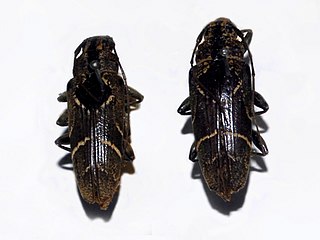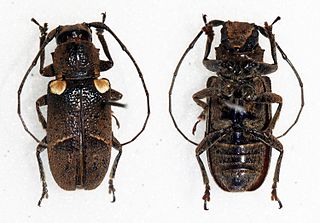Related Research Articles
Genus is a taxonomic rank used in the biological classification of living and fossil organisms as well as viruses. In the hierarchy of biological classification, genus comes above species and below family. In binomial nomenclature, the genus name forms the first part of the binomial species name for each species within the genus.

Extinction is the termination of a kind of organism or of a group of kinds (taxon), usually a species. The moment of extinction is generally considered to be the death of the last individual of the species, although the capacity to breed and recover may have been lost before this point. Because a species' potential range may be very large, determining this moment is difficult, and is usually done retrospectively. This difficulty leads to phenomena such as Lazarus taxa, where a species presumed extinct abruptly "reappears" after a period of apparent absence.

The cicadas are a superfamily, the Cicadoidea, of insects in the order Hemiptera. They are in the suborder Auchenorrhyncha, along with smaller jumping bugs such as leafhoppers and froghoppers. The superfamily is divided into two families, the Tettigarctidae, with two species in Australia, and the Cicadidae, with more than 3,000 species described from around the world; many species remain undescribed.

The International Union for Conservation of Nature (IUCN) Red List of Threatened Species, founded in 1964, is the world's most comprehensive inventory of the global conservation status of biological species. It uses a set of criteria to evaluate the extinction risk of thousands of species and subspecies. These criteria are relevant to all species and all regions of the world. With its strong scientific base, the IUCN Red List is recognized as the most authoritative guide to the status of biological diversity. A series of Regional Red Lists are produced by countries or organizations, which assess the risk of extinction to species within a political management unit.

The conservation status of a group of organisms indicates whether the group still exists and how likely the group is to become extinct in the near future. Many factors are taken into account when assessing conservation status: not simply the number of individuals remaining, but the overall increase or decrease in the population over time, breeding success rates, and known threats. Various systems of conservation status exist and are in use at international, multi-country, national and local levels as well as for consumer use.

Monochamus is a genus of longhorn beetles found throughout the world. They are commonly known as sawyer beetles or sawyers, as their larvae bore into dead or dying trees, especially conifers such as pines. They are the type genus of the Monochamini, a tribe in the huge long-horned beetle subfamily Lamiinae, but typically included in the Lamiini today.
In biology, a species is the basic unit of classification and a taxonomic rank of an organism, as well as a unit of biodiversity. A species is often defined as the largest group of organisms in which any two individuals of the appropriate sexes or mating types can produce fertile offspring, typically by sexual reproduction. Other ways of defining species include their karyotype, DNA sequence, morphology, behaviour or ecological niche. In addition, paleontologists use the concept of the chronospecies since fossil reproduction cannot be examined.
Uvarus is a genus of beetles in the family Dytiscidae, containing the following species:

Neivamyrmex is a genus of army ants in the subfamily Dorylinae. Most species are predominantly subterranean, but they will occasionally forage above ground at night or on cloudy days.

Tmesisternus is a genus of longhorn beetles belonging to the family Cerambycidae, subfamily Lamiinae.

Crossotini is a tribe of longhorn beetles of the subfamily Lamiinae. It was described by Thomson in 1864.
Mimauxa is a genus of longhorn beetles of the subfamily Lamiinae, containing the following species:
Oculohammus densepunctatus is a species of beetle in the family Cerambycidae, and the only species in the genus Oculohammus. It was described by Breuning and de Jong in 1941.
Mimogrynex densepunctatus is a species of beetle in the family Cerambycidae, and the only species in the genus Mimogrynex. It was described by Stephan von Breuning in 1939.

Prosoplus is a genus of longhorn beetles of the subfamily Lamiinae, containing the following species:
Mimauxa densepunctatus is a species of beetle in the family Cerambycidae. It was described by Breuning in 1957.
Mimetaxalus densepunctatus is a species of beetle in the family Cerambycidae. It was described by Breuning in 1957. It is known from Madagascar.
Monochamus densepunctatus is a species of beetle in the family Cerambycidae. It was described by Stephan von Breuning in 1980.
Prosoplus densepunctatus is a species of beetle in the family Cerambycidae. It was described by Stephan von Breuning in 1938.
References
- ↑ Biolib.cz - Sophronicomimus densepunctatus. Retrieved on 8 September 2014.